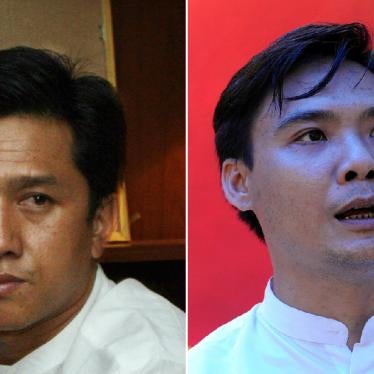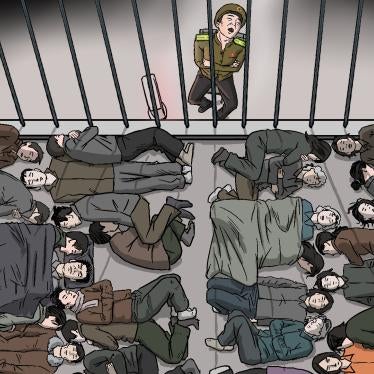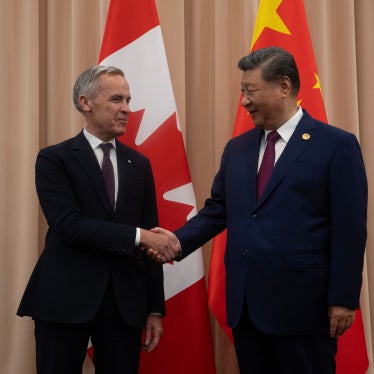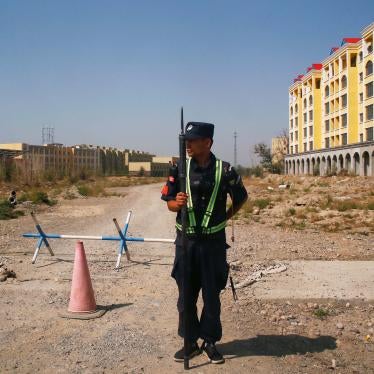(悉尼)-人權觀察今天表示,緬甸軍方和警方應為2021年2月1日軍事政變以來的大量在押死亡案件負責。
人權觀察紀錄到六宗社運人士在押死亡案件,均涉及明顯酷刑或剝奪適當醫療照護。軍政府當局沒有認真調查這些命案,也沒有查辦失職人員。
「人權觀察記錄到的六宗死亡案件,只是緬甸軍警拘押人員所受苦難與酷刑的冰山一角,」人權觀察緬甸研究員曼尼.貌(Manny Maung)說。「由於軍政府全面實施殘暴統治,至今未有任何具體行動調查在押死亡案件及懲治相關人員並不意外。」
軍政府應立即停止針對反抗軍事統治人士的侵犯人權行為,包括任意逮捕拘押、酷刑虐待以及不公正審判。在押死亡案件應立即備妥充分紀錄通知死者家屬,遺體應予返還,侵犯人權人員應予查辦。
據設於泰國的政治犯救援會(Assistance Association for Political Prisoners)估計,自從軍方以政變結束昂山素季與全國民主聯盟(全民盟)領導的民主轉型以來,至少有72人死於警方或軍方拘押之下,包括在警察派出所、軍方審訊處和監獄。這些死亡案件只占安全部隊逮捕後短期內遇害的至少690人中的一小部分,後者大多發生在少數民族區域的軍事行動中。軍政府只承認極少數在押死亡案件,並將死因歸咎於疾病或心臟衰竭。然而,人權活動者、目擊者和接近死者的消息來源表示,根據現有物證,許多人顯然死於酷刑或其他虐待,包括惡劣的拘押條件以及無法獲得適當的醫療照護。
人權觀察在今年5月到7月記錄到六宗死亡案件,對10名目擊者和家屬進行遠距訪談,檢視發布在社交媒體的40張照片和5支影片,並由一位專長酷刑診斷的急診專科醫師根據可視證據做出獨立醫學分析。
六名男性死者都曾從事政治活動或發聲反對軍事統治,分別來自仰光、曼德勒和實皆省。全民盟成員欽貌拉(Khin Maung Latt,58歲)、梭密林(Zaw Myat Lynn,46歲)和譚敦吾(Than Tun Oo,48歲)顯然因為政治立場被捕。凱迪(Khet Thi,43歲)、丁貌敏(Tin Maung Myint,52歲)和覺瑞迎(Kyaw Swe Nyein,55歲)則是在政變後加入或領導抗議運動。其中五人在被逮捕審問後24小時內死亡,覺瑞迎則死於被捕兩個月後。
這六名死者中有五人是在緬甸軍警夜間突襲檢查時被捕,譚敦吾是白天在曼德勒被抓。六人中有五人是被軍警聯合執勤逮捕。根據今年3月立法,警方正式隸屬於軍方管控之下,警員必須全面服從軍方命令,包括參與軍方任務。
其中五名死者的照片顯示,他們的軀幹或頭部留有疑似酷刑的傷痕。譚敦吾沒有留下遺體照片,軍政府當局說他死後馬上就被火化了。
急診專科醫師羅希尼.哈爾(Rohini Haar)應人權觀察要求對遺體影像做了分析:「檢查過五名被害人的遺體照片和影片後,從軀幹和臉部的傷痕可以明顯看出這幾名男性曾經遭受極大痛苦,酷刑確有發生⋯那麼多的虐待和酷刑痕跡,很難從中確定這些人的直接死因。」
五名男性的家屬都沒有拿到正式的醫療證明、死因或驗屍報告,儘管證據顯示六具遺體中有四具曾進行屍檢。軍政府應發出所有在押死亡案件的醫療證明,若有驗屍則應向家屬提供驗屍報告。
四名被害人的家屬表示,他們感到官員施壓立即火化遺體,應該是為了湮滅不法證據。兩名家屬說他們迅速將親人埋葬,以防遺體遭當局沒收。
聯合國緬甸人權狀況特別報告員於2021年10月表示,他收到可靠報告指「逾8千人遭任意拘留,其中許多遭到酷刑,包括數十人被刑求致死。」今年3月在聯合國人權理事會上,聯合國人權事務高級專員米歇爾・巴切萊特表示,她收到可靠報告指安全部隊殺害者中至少百分之21死於拘押期間。
人權觀察發現,軍政府自政變後實施普遍有計畫的侵犯人權行為,足以構成危害人類罪,包括謀殺、酷刑和非法監禁。
聯合國《關於調查潛在非法死亡的明尼蘇達規程》(2016)規定,所有羈押期間死亡案件的案情與原因均應得到「迅速、公正和有效的調查」。此外,「應立即通知家屬,隨後以便於周知的方式張貼死亡通知。還應在屍檢前盡可能徵求家屬的意見。家屬應有權要求屍檢期間有代理人在場。遺骸應⋯交還家屬,使其能夠根據自身信仰處理遺骸。」
人權觀察表示,聯合國、區域機構和各國政府——包括歐洲聯盟、美國、英國和東南亞國家聯盟(東盟)——應對在押死亡表示特別關切,並施壓軍政府終結這種狀況。相關各方應加強對敏昂萊大將為首的軍方與國家管理委員會軍政府以及軍方掌控企業實施針對制裁。
聯合國安全理事會應對緬甸軍政府採取緊急措施,包括將該國情勢移交國際刑事法院,以及通過全球武器禁運決議。
「在押人員死亡是軍政府安全部隊日復一日犯下的隱形暴行之一,」貌說。「有關各國政府應確保如此駭人的人權侵犯受到全球一致譴責。」
更多詳情請見下文(只有英文)。
Deaths in Custody
The following case histories are based on remote interviews with family members of the victims and witnesses and other sources of information. In all but one of the cases, witnesses said they were afraid to be named due to fear of reprisals from the Myanmar military or police.
Kyaw Swe Nyein, Nyaung-U town, Mandalay Region
Plainclothes policemen and a military intelligence unit arrested Kyaw Swe Nyein, 55, at his home in Mandalay Region on January 30, 2022, after he joined protests in Nyaung-U, Mandalay Region.
The authorities accused Kyaw Swe Nyein of spreading “fake news” and sharing a Facebook post supporting anti-coup protests. A closed court in March sentenced him to six months in prison for incitement under section 505A of the penal code. This section, amended by the junta shortly after the coup, makes it a criminal offense to make comments that “cause fear” and spread “false news,” and is punishable by up to three years in prison.
On March 9, Kyaw Swe Nyein sounded well when he spoke to his family on a mobile phone borrowed from one of the prison guards at Nyaung-U prison. However, he told a family member that he had been badly beaten at the Myingyan interrogation center, where he was held for the first 10 days. He told his family that he had experienced some dizziness as a result. On March 11, prison authorities informed Kyaw Swe Nyein’s wife that he had died that evening after complaining of dizziness. Doctors at Nyaung-U hospital, where his body was taken, told relatives that he had died of heart failure.
The family did not receive a death certificate or an autopsy report, even though authorities conducted an autopsy. A family member said a police official told the family to sign a blank document acknowledging they were informed of Kyaw Swe Nyein’s death.
A family member said:
I was so distressed. I just signed the document, but I don’t know what it was, and I don’t have a copy.… If he died from natural causes, then I could forgive myself [that he died in prison] but now, it’s the unknown that is unsettling. Of course, it’s very difficult for us to accept his death with so few answers but we can’t do anything about it now.
After reviewing images of Kyaw Swe Nyein at his funeral, Dr. Haar said a photograph showed evidence of trauma to the head from bruising around the eyes and ears.
Than Tun Oo, Mandalay town, Mandalay Region
On September 26, 2021, at about 3:30 p.m., soldiers and police arrested Than Tun Oo, 48, a former political prisoner and activist, at his home in Mandalay and took him to the No. 7 Area Police Station. Neighbors and family members watched as security forces beat him with his hands tied behind his back and then shot him in the legs, supposedly for being slow to respond to orders. A witness said:
There were around 50 to 100 soldiers and police with army trucks and private cars. Some soldiers were from the LID [Light Infantry Division] 33 command and there were police from the local station here in Mandalay.… They told [Than Tun Oo] to kneel but he weighed 400 pounds, so they shot him in his leg to make him kneel.
The witness said the next day, September 27, police and military officials told Than Tun Oo’s family that he had died in the police station from heart failure. The authorities did not give the family a medical certificate, a witness said, but security forces made family members sign a document acknowledging they had been informed of Than Tun Oo’s death.
The family said Than Tun Oo was in good health prior to his arrest. When the family demanded his body, junta authorities said they had cremated the body immediately because Than Tun Oo had tested positive for Covid-19 while in custody.
A family member said:
Everyone has dreams, so did [Than Tun Oo]. He was interested in art and loved writing. Many people liked him. I could endure the pain of loss if he died while fighting against the [junta]. But he died during interrogation where they have the power to do whatever they wanted. It is painful to accept that he died in this way.
Khet Thi, Shwebo city, Sagaing Region
Khet Thi, 43, a popular poet known for his sharp political wit, took on a leadership role opposing the military coup. He organized protests and spoke at rallies to encourage dissent against the military. His poetry became part of his resistance to military rule. “They shoot in the head, but they don't know that revolution is in the heart,” he wrote.
On May 8, 2021, about 40 soldiers and police arrested Khet Thi at his home in the city of Shwebo, Sagaing Region, and accused him of leading a plan to lay landmines targeting the security forces. Junta authorities also arrested Khet Thi’s wife, Chaw Suu, and her brother-in-law, Aye Pyo, for allegedly helping to plan the attack.
A witness said that police handcuffed all three, then took them in a police vehicle to Myo Ma, the main police station in Shwebo, where they were separated into male and female cellblocks for interrogation.
After hours of interrogation overnight, Chaw Suu and her brother-in-law were released on the morning of May 9. A police officer informed Chaw Suu that her husband had been taken to Monywa General Hospital, almost 90 kilometers from Myo Ma police station. Sources familiar with the case said that Chaw Suu thought her husband was ill and asked the head of the police station to take her to the hospital so she could care for him. The officer in charge then told her that Khet Thi was dead.
On May 9, at about 2 p.m., junta officials at Monywa hospital told Khet Thi’s family that he had died of a heart attack. However, family members deny that he had any heart problems, and say he was in good health apart from poor eyesight. A source said hospital staff pressured the family to have the body cremated at the hospital the same day. Fearing junta officials would force them to immediately cremate Khet Thi, the family took his body to prepare for burial the next day.
Junta officials failed to provide the family a medical certificate or autopsy report, and there was no investigation into his death.
A family member said:
We rushed back to another township with his body because we were afraid that they would take the body back.… When we went to prepare the body, his head moved slightly and that’s when blood came out of his head. They had performed an autopsy on his head and there was a wound but there were also two bruises on the right side of his face and black marks on his nose. He had square shaped burn marks on his thighs. We didn’t check his back because we were afraid the sutures from the autopsy might burst open.
Khet Thi was buried on May 10, 2021, less than 48 hours after his arrest.
Dr. Haar, the emergency physician, said that images of Khet Thi taken after his death showed likely head trauma.
Zaw Myat Lynn, Shwe Pyi Thar township, Yangon
Zaw Myat Lynn, 46, was a former NLD member who ran a vocational education school named after Aung San Suu Kyi in Yangon’s Shwe Pyi Thar township. He and his family lived with the students.
On March 9, 2021, at about 1 a.m., police and soldiers arrived at the school, appearing to target Zaw Myat Lynn for arrest due to pro-democracy posts on his Facebook account. He ran and jumped over a fence but was surrounded by police and soldiers who took him into a military vehicle.
A teacher said:
I heard from students around 2 a.m. on March 9, 2021. [They told me] about 40 police and soldiers were at the Suu Vocational School. Some students were arrested first when military forces came in from the front door. Zaw Myat Lynn jumped over the fence and cleared it, but the building was surrounded, and he was arrested. Neighbors from next door also told me they heard Zaw Myat Lynn say, “Don’t shoot, I’ll surrender and come with you.” He didn’t get any injury from jumping over that fence.
Zaw Myat Lynn’s family was told the next day to come and identify his corpse.
Dr. Haar, who reviewed 12 photographs and 2 videos of Zaw Myat Lynn’s body, said visible injuries suggested scalding liquid was poured onto his face.
After examining similar photographs, The Guardian newspaper concluded that the nature of Zaw Myat Lynn’s injuries were consistent with torture: “It appears that boiling water or a chemical solution had been poured into his mouth. The tongue was melted, his teeth missing. Facial skin was peeling off. The body had been wrapped up to conceal further traumatic injuries.”
A source close to the family said that junta officials told Zaw Myat Lynn’s family that he had died from heart failure. The officials failed to provide the family with a medical certificate or autopsy report.
Tin Maung Myint, Yin Mar Bin township, Sagaing Region
On April 4, 2021, soldiers arrested Tin Maung Myint, 52, during a raid on his village in Yin Mar Bin township, Sagaing Region. He was a farmer and village leader who had joined the opposition to the junta. Witnesses said that soldiers arrested Tin Maung Myint around 4 a.m. along with seven others who were keeping watch on the military column that was preparing to raid their village.
Tin Maung Myint’s body, along with that of another villager who was arrested with him, turned up the next day about 2 p.m. at the Monywa General Hospital, bearing marks of torture. A witness who viewed the body said:
I saw bruises and swollen marks all over his and the other victim’s face. They were in pretty bad shape. We only checked their faces, not their whole bodies. It was unsettling to get close to their bodies. I didn’t want to look that closely, so I don’t know about marks on their bodies, but their faces were so black and blue.
One photograph posted on social media of Tin Maung Myint’s body shows numerous wounds. Dr. Haar, who reviewed the photograph, said she observed massive trauma consistent with skin tears and avulsions – or forcible tearing – on his shoulders that looked like burns. Bruises are visible on the face, as is a deep gash on the forehead. She said it was unclear which injury was the cause of death.
Junta authorities failed to provide a death certificate to the family or explain how Tin Maung Myint had died. Hospital staff who found the bodies told the families the men were already dead when they were discovered dumped at the hospital.
Khin Maung Latt, Pabedan township, Yangon
On March 6, 2021, soldiers and police arrived at the home of Khin Maung Latt, 58, a ward chairman and NLD member, in Pabedan township, Yangon. Witnesses said that after forcibly entering his home, security forces beat and kicked Khin Maung Latt in front of his family, then took him away at gunpoint. His family was notified the next morning that he had died of heart failure, and they retrieved his body at 8 a.m.
A friend of Khin Maung Latt’s who attended his funeral on March 7 said that his legs looked broken, his white funeral shroud was covered in blood, and that his face appeared blue and swollen. The friend said:
When I arrived at Ye Way cemetery, Khin Maung Latt’s body was already being prepared in the morgue, in the Muslim tradition. But we’d instructed our contacts who washed the body to take photos as soon as they’d stripped him. The water ran with blood and his body was marked as if he was badly beaten.… There was blood coming out of his ears and bruises all over his body; his legs looked damaged, broken. The person washing the body had put gauze in the ear and up his nose, but it was still dripping.… The white cloth was no longer white, it was stained red and rust-colored.
He said that the authorities appeared to have carried out an autopsy:
They said he died from a heart attack, but they had performed an autopsy on his body and on his head. The head was cut open, as if they’d taken one side and pulled it back like a flap. But why did they do this? There was no explanation given.… You could see the stitches on his head and on his body and the stitches were still oozing. No matter how we washed the stitches, they kept oozing and his blood was still warm. There were blue and brown marks around his eyes and his body, marks everywhere.
A member of the Muslim community who helped to prepare Khin Maung Latt’s body for a Muslim burial said there were deep wounds on his back and hands consistent with torture.
Dr. Haar, who reviewed nine photographs and one video of Khin Maung Latt’s body, observed unskilled, haphazard suturing of the autopsy wounds on the head and chest: “The sutures are very unusual and not in line with medical best practice. By even conducting the autopsy under such unusual circumstances, may also suggest medical complicity to the acts of torture that clearly occurred to the individual.”
Khin Maung Latt’s body was cremated at the Ye Way cemetery on March 7, less than 24 hours after his arrest. The friend said officials failed to provide the family with a medical certificate or autopsy report.






